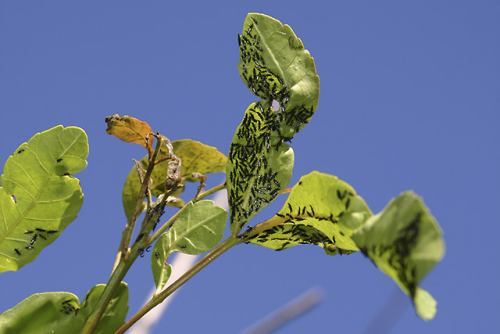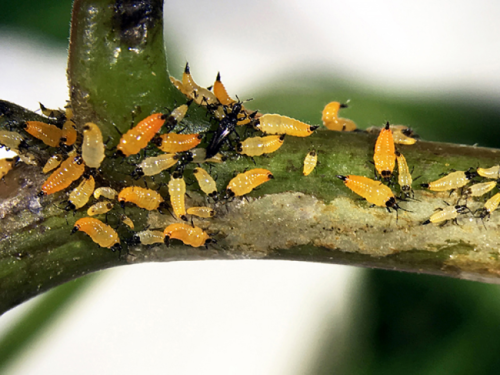| Information about (Schinus terebinthifolius) Brazilian Peppertree and recent Biocontrol Release |

|

Schinus terebinthifolius or Brazilian Peppertree is a native of Brazil, Paraguay and Argentina and was introduced in Florida as an ornamental shrub. Brazilian pepper is ranked among the most important threats to biodiversity in the South Florida ecosystem and occupies more area in the state than any other invasive species. This shrub not only threatens endangered flora and fauna but many citizens suffer from allergic reactions to the airborne volatiles produced. Currently, there are over 700,000 acres in Florida infested with Brazilian pepper tree. This plant produces a dense canopy that shades out all other plants and provides a very poor habitat for native species.
Thrips Show Promise in Controlling the Invasive Brazilian Peppertree in Florida
October 12, 2022
Brazilian peppertree thrips (Pseudophilothrips ichini) showed promise as biological control agents for invasive Brazilian peppertree populations in Florida according to a recent study published in the Florida Entomologist.
Thrips are common insect pests on horticultural plants, but specialized Brazilian peppertree thrips from South America feed exclusively on the Brazilian peppertree's leaves and stem tips. Their feeding results in reducing the peppertree's growth rate, plant height, number of leaves, and green stems as well as fruit and flower production.
Scientists from the United States Department of Agriculture's Agricultural Research Service (ARS) collaborated with University of Florida and Florida Department of Food and Consumer Services researchers to mass produce and release thrips throughout 567 sites in Florida between May 2019 and December 2021.

Adult Brazilian peppertree thrips feed on a Brazilian peppertree's leaves. (Photo by Gregory Wheeler, D4383-1)
The study results show that these thrips persisted in 60 percent of the survey sites for at least one generation as indicated by the recovery of adult thrips at least 60 days after their release.
"This is a significant finding, because it indicates the thrips have a self-sustaining population at up to 60 percent," said Gregory Wheeler, research entomologist at the ARS Invasive Plant Research Laboratory in Fort Lauderdale, Florida.
Native to South America, the Brazilian peppertree is a woody and evergreen shrub known for its bright red berries and green foliage. This invasive species grows in dense thickets in invaded ranges and crowds native vegetation. Its fruit is toxic when consumed by wildlife, and many people have allergic reactions to its pollen and sap.
In the U.S., the Brazilian peppertree has made its way to California, Florida, Hawaii, and Texas. In Florida alone, the Brazilian peppertree tree has colonized most of the state's peninsula and covers more than 700,000 acres of land.

Brazilian peppertree thrips larvae and adults feed on a Brazilian peppertree. (Photo by Dale Halbritter, D4993-1)
Use of biological control agents can be a solution for land managers seeking to control invasive populations, according to Wheeler.
"Biological control agents like thrips can be a cost-effective and environmentally friendly means of pest control that can be a part of an integrated approach that includes a number of different tactics," said Wheeler.
Thrips are the first biological control agent for this invasive species released in Florida. Researchers will continue field releases and assessments to determine thrips' effectiveness.
The Agricultural Research Service is the U.S. Department of Agriculture's chief scientific in-house research agency. Daily, ARS focuses on solutions to agricultural problems affecting America. Each dollar invested in U.S. agricultural research results in $20 of economic impact.


Dr. Dale Halbritter and scientific technician Jorge Leidi releases thrips in a field site.
Please click the link below for the published mass rearing details from IPRL:
If you would be interested in requesting the biological control agent Thrips (Pseudophilothrips ichini) for the Brazilian Peppertree (Schinus terebinthifolius) on your public land please download the PDF form below and click "fill and sign" on the right tool bar to fill out your information. Then save and send the request form via email to: min.rayamajhi@usda.gov
Thrips Request Form for Public Land
Scientists Reunite Old Acquaintances to Control Unwelcome Guests
Click this link to download more detailed research information.


